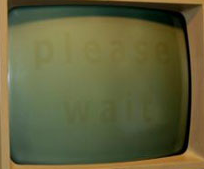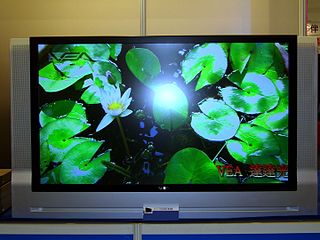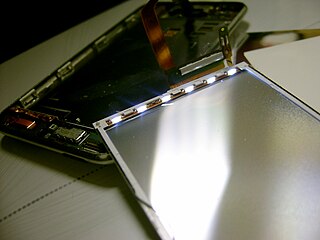Related Research Articles

A computer monitor is an output device that displays information in pictorial or textual form. A discrete monitor comprises a visual display, support electronics, power supply, housing, electrical connectors, and external user controls.

A liquid-crystal display (LCD) is a flat-panel display or other electronically modulated optical device that uses the light-modulating properties of liquid crystals combined with polarizers to display information. Liquid crystals do not emit light directly but instead use a backlight or reflector to produce images in color or monochrome.

Interlaced video is a technique for doubling the perceived frame rate of a video display without consuming extra bandwidth. The interlaced signal contains two fields of a video frame captured consecutively. This enhances motion perception to the viewer, and reduces flicker by taking advantage of the characteristics of the human visual system.
The flicker fusion threshold, also known as critical flicker frequency or flicker fusion rate, is the frequency at which a flickering light appears steady to the average human observer. It is a concept studied in vision science, more specifically in the psychophysics of visual perception. A traditional term for "flicker fusion" is "persistence of vision", but this has also been used to describe positive afterimages or motion blur. Although flicker can be detected for many waveforms representing time-variant fluctuations of intensity, it is conventionally, and most easily, studied in terms of sinusoidal modulation of intensity.

A video projector is an image projector that receives a video signal and projects the corresponding image onto a projection screen using a lens system. Video projectors use a very bright ultra-high-performance lamp, Xenon arc lamp, metal halide lamp, LED or solid state blue, RB, RGB or fiber-optic lasers to provide the illumination required to project the image. Most modern projectors can correct any curves, blurriness and other inconsistencies through manual settings.
The refresh rate, also known as vertical refresh rate or vertical scan rate in reference to terminology originating with the cathode-ray tubes (CRTs), is the number of times per second that a raster-based display device displays a new image. This is independent from frame rate, which describes how many images are stored or generated every second by the device driving the display. On CRT displays, higher refresh rates produce less flickering, thereby reducing eye strain. In other technologies such as liquid-crystal displays, the refresh rate affects only how often the image can potentially be updated.

A backlight is a form of illumination used in liquid-crystal displays (LCDs) that provides illumination from the back or side of a display panel. LCDs do not produce light by themselves, so they need illumination to produce a visible image. Backlights are often used in smartphones, computer monitors, and LCD televisions. They are used in small displays to increase readability in low light conditions such as in wristwatches. Typical sources of light for backlights include light-emitting diodes (LEDs) and cold cathode fluorescent lamps (CCFLs).
An output device is any piece of computer hardware that converts information or data into a human-perceptible form or, historically, into a physical machine-readable form for use with other non-computerized equipment. It can be text, graphics, tactile, audio, or video. Examples include monitors, printers, speakers, headphones, projectors, GPS devices, optical mark readers, and braille readers.
A thin-film-transistor liquid-crystal display is a type of liquid-crystal display that uses thin-film-transistor technology to improve image qualities such as addressability and contrast. A TFT LCD is an active matrix LCD, in contrast to passive matrix LCDs or simple, direct-driven LCDs with a few segments.

An active shutter 3D system is a technique of displaying stereoscopic 3D images. It works by only presenting the image intended for the left eye while blocking the right eye's view, then presenting the right-eye image while blocking the left eye, and repeating this so rapidly that the interruptions do not interfere with the perceived fusion of the two images into a single 3D image.

Screen burn-in, image burn-in, ghost image, or shadow image, is a permanent discoloration of areas on an electronic visual display such as a cathode-ray tube (CRT) in an older computer monitor or television set. It is caused by cumulative non-uniform use of the screen.
Flicker-free is a term given to video displays, primarily cathode ray tubes, operating at a high refresh rate to reduce or eliminate the perception of screen flicker. For televisions, this involves operating at a 100 Hz or 120 Hz hertz field rate to eliminate flicker, compared to standard televisions that operate at 50 Hz or 60 Hz (NTSC), most simply done by displaying each field twice, rather than once. For computer displays, this is usually a refresh rate of 70–90 Hz, sometimes 100 Hz or higher. This should not be confused with motion interpolation, though they may be combined – see implementation, below.
This article discusses moving image capture, transmission and presentation from today's technical and creative points of view; concentrating on aspects of frame rates.

A raster scan, or raster scanning, is the rectangular pattern of image capture and reconstruction in television. By analogy, the term is used for raster graphics, the pattern of image storage and transmission used in most computer bitmap image systems. The word raster comes from the Latin word rastrum, which is derived from radere ; see also rastrum, an instrument for drawing musical staff lines. The pattern left by the lines of a rake, when drawn straight, resembles the parallel lines of a raster: this line-by-line scanning is what creates a raster. It is a systematic process of covering the area progressively, one line at a time. Although often a great deal faster, it is similar in the most general sense to how one's gaze travels when one reads lines of text.

Large-screen television technology developed rapidly in the late 1990s and 2000s. Prior to the development of thin-screen technologies, rear-projection television was standard for larger displays, and jumbotron, a non-projection video display technology, was used at stadiums and concerts. Various thin-screen technologies are being developed, but only liquid crystal display (LCD), plasma display (PDP) and Digital Light Processing (DLP) have been publicly released. Recent technologies like organic light-emitting diode (OLED) as well as not-yet-released technologies like surface-conduction electron-emitter display (SED) or field-emission display (FED) are in development to supersede earlier flat-screen technologies in picture quality.
Display motion blur, also called HDTV blur and LCD motion blur, refers to several visual artifacts that are frequently found on modern consumer high-definition television sets and flat-panel displays for computers.
A multiple-sync (multisync) monitor, also known as a multiscan or multimode monitor, is a raster-scan analog video monitor that can properly synchronise with multiple horizontal and vertical scan rates. In contrast, fixed frequency monitors can only synchronise with a specific set of scan rates. They are generally used for computer displays, but sometimes for television, and the terminology is mostly applied to CRT displays although the concept applies to other technologies.

An LED-backlit LCD is a liquid-crystal display that uses LEDs for backlighting instead of traditional cold cathode fluorescent (CCFL) backlighting. LED-backlit displays use the same TFT LCD technologies as CCFL-backlit LCDs, but offer a variety of advantages over them.
Developed by Mitsubitshi Electric Research Laboratories, a privacy-enhanced computer display allows information that must remain private to be viewed on computer displays located in public areas by employing the use of both ferroelectric shutter glasses and a unique device driver.
The following table compares cathode-ray tube (CRT), liquid-crystal display (LCD), plasma and organic light-emitting diode (OLED) display device technologies. These are the most often used technologies for television and computer displays. A less detailed comparison of a wider variety of display technologies is available at Comparison of display technology.
References
- ↑ "Liquid crystal display (LCD):Polarity inversion | video equipment". Archived from the original on 2018-03-06. Retrieved 2018-03-05.
- ↑ "Inversion (pixel-walk) - Lagom LCD test". www.lagom.nl.
- ↑ "Pulse Width Modulation (PWM)". 17 March 2015.
- ↑ "Flicker free monitors | IrisTech". 2 April 2016.
- ↑ "3D printing & direct imaging products". Texas Instruments. November 1, 2022. Retrieved November 1, 2022.
- ↑ "Why Is the US Standard 60 Hz? - News". www.allaboutcircuits.com. Retrieved 2022-11-03.
- ↑ Campbell, Todd (November 3, 2022). "Answer Geek:How Chewing Affects TV Flicker". ABC News (Website) (1st ed.). United States of America. p. 1. Retrieved 2022-11-03.
- ↑ "Tutorials | Catch22". Archived from the original on 2014-07-14. Retrieved 2007-01-25.
- ↑ Leosoft Ltd. "Eye Saver". www.eye-saver.net.
- 1 2 "Monitor Flicker". Image Science. Retrieved 2022-11-03.